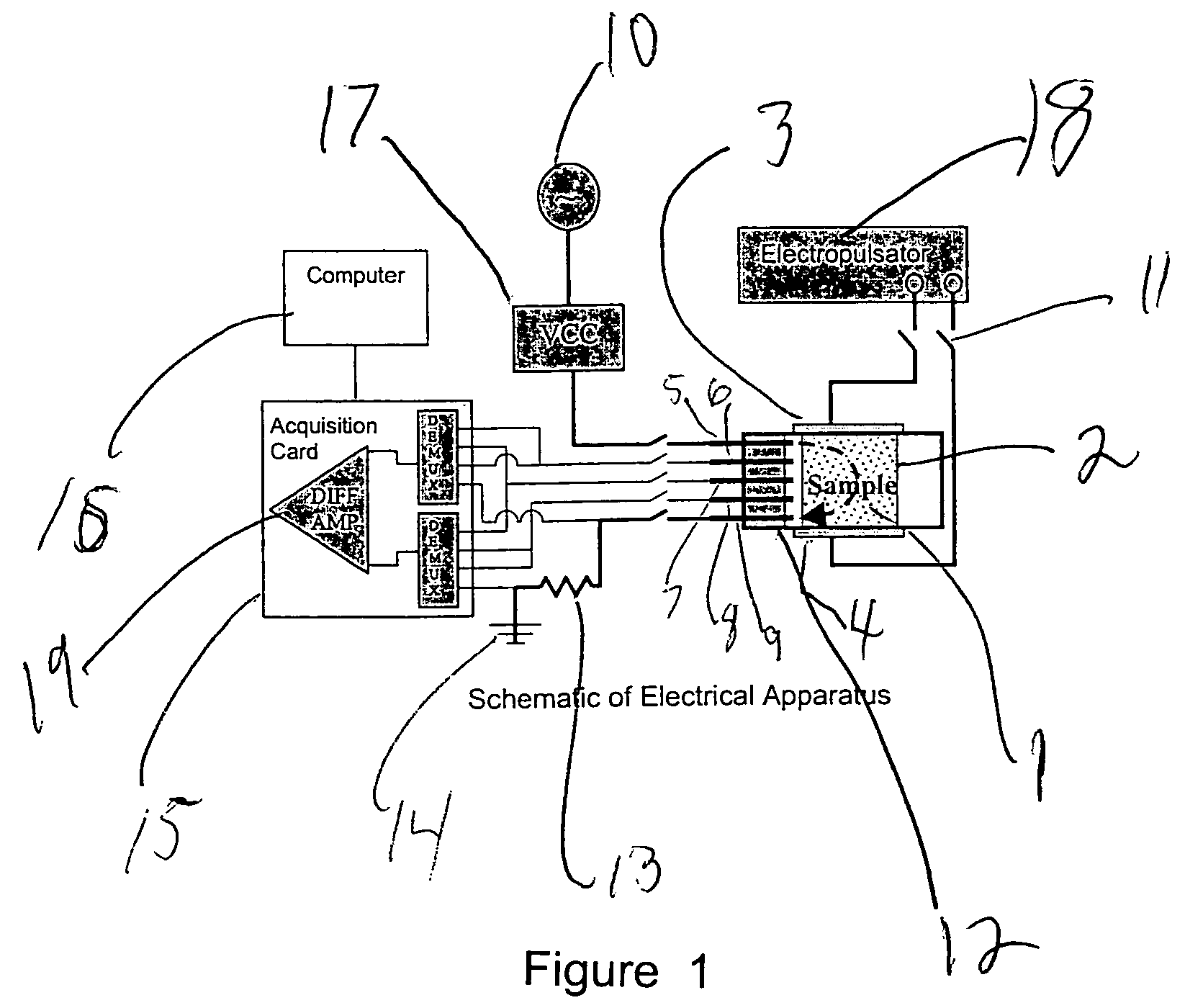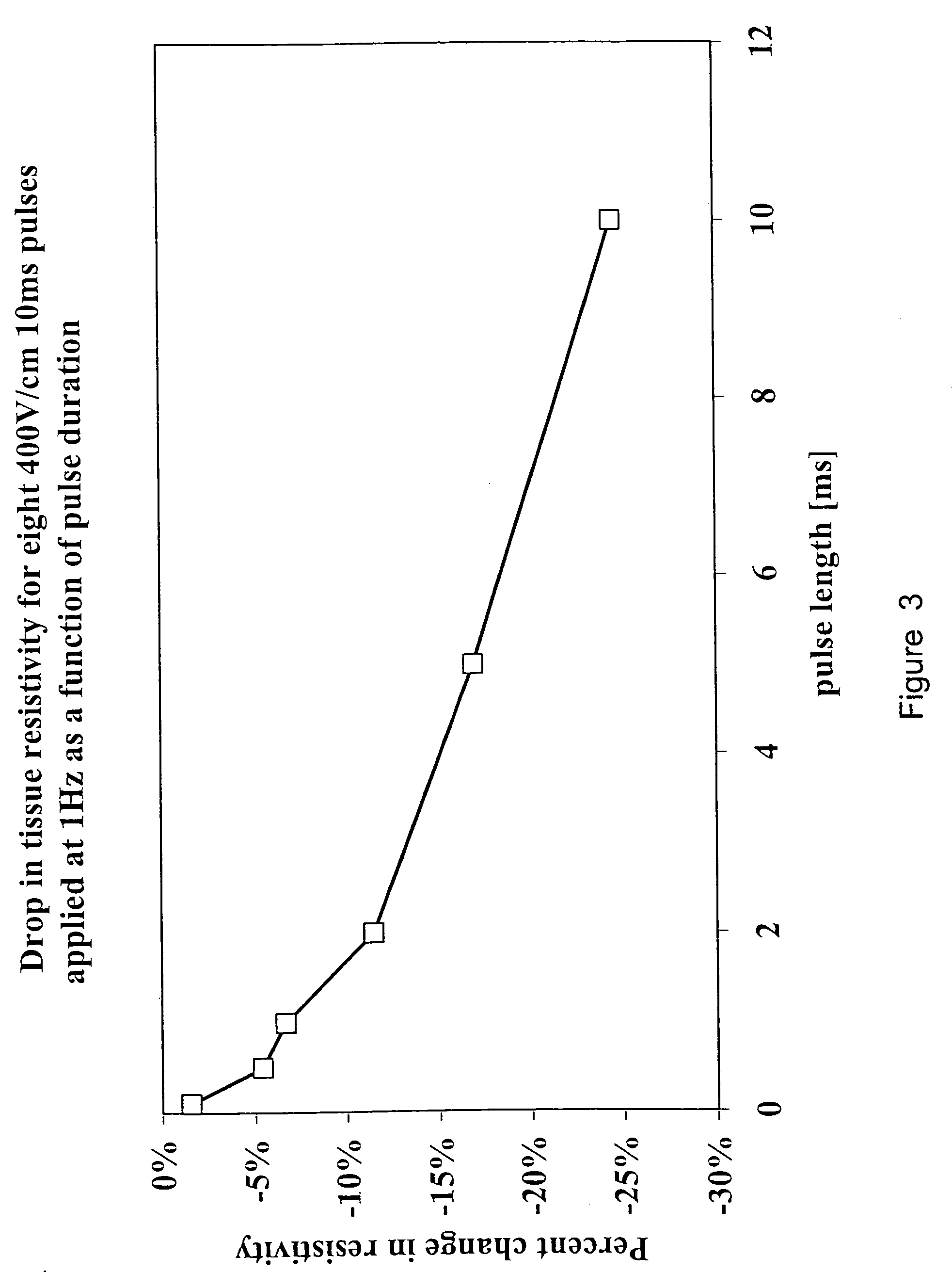Controlled electroporation and mass transfer across cell membranes in tissue
a cell membrane and cell technology, applied in the field of tissue electroporation, can solve the problems of inability to control the process of electroporation in both individual cells and tissues in real time, low efficiency of transfection by electroporation, and inability to adapt the specific characteristics of individual cells to the current procedure, etc., to achieve the effect of minimizing cellular damage and high efficiency of electrical energy us
- Summary
- Abstract
- Description
- Claims
- Application Information
AI Technical Summary
Benefits of technology
Problems solved by technology
Method used
Image
Examples
example 1
Materials
[0057]Cells—Two types of cells were examined: Mouse skin fibroblasts (NIH 3T3 cell line) and primary skeletal satellite cells. Satellite cells were isolated and expanded. The cells were plated on membrane inserts (Millicel-PCF, # PIHP03050 Millipore, USA) and incubated for 5 days in culture medium (DMEM, 10% Fetal calf serum, 1% L-glutamine, antibiotics, Biological industries, Bet Haeemek, Israel) in 6 wells plates until desired confluence was achieved.
[0058]Tissue—Liver was obtained from Spraque Dewley rats (250–350 gr), and used within 10 minutes from resection. The liver was removed from the anesthetized rat and sliced with a scalpel to a thickness ranging from 1 mm to 4 mm. Then a disk of liver was obtained by pressing a sharp circular tube onto the sample to trim the excess tissue. The resulting sample can then placed in a device as shown in FIG. 1 for measurement. For negative controls livers can used and should be kept prior to resection in a refrigerator at 4° C.
Ele...
example
Numerical Method
[0088]A simplified two-dimensional isotropic cross-section of a liver 7 cm in diameter is used for the simulation. The surface of the analyzed tissue is assumed to be electrically isolated with a zero flux boundary condition to simulate a situation in which the liver is temporarily placed in an insulating, semi-rigid electrode array fixture during a surgical procedure. To collect data for the reconstruction algorithm, 32 electrodes are equally spaced around the periphery of the virtual phantom, i.e. electroporation conductivity map.
Experimental Results used in Front-Tracking
[0089]For computational reasons and for model demonstration, we used the data from the 10 ms pulses in this study. Specifically, with these experiments, eight 10 ms pulses at a frequency of 1 Hz were delivered for electric fields of 0, 200, 300, 400 and 500V cm″1. The threshold gradient required to induce electroporation was taken from the experimental data and was shown to...
example 2
Electroporation Model
[0090]The electroporation simulation evaluates the potential and gradient distribution in the tissue due to an electrical pulse using the finite element method. To account for the change in electrical properties of the tissue during electroporation, the algorithm iteratively solves the Poisson equation with a zero source term:
∇·(σ∇φ)=0
[0091]where σ is the electrical conductivity and φ is the electrical potential. The conductivity of the tissue is assumed to be initially at 0.13 S m−1, which agrees with results for dog liver in situ at IkHz and measured from one sample. At locations where the voltage gradient surpasses a threshold gradient, the conductivity increases as prescribed by experimental results in FIG. 10. The gradients are recalculated with the updated conductivity values until the solution converges. For convergence, it was assumed that once the conductivity of an element increases, it will not revert to a lower value, at least within the duration of ...
PUM
| Property | Measurement | Unit |
|---|---|---|
| porosity | aaaaa | aaaaa |
| thickness | aaaaa | aaaaa |
| frequency | aaaaa | aaaaa |
Abstract
Description
Claims
Application Information
 Login to View More
Login to View More - R&D
- Intellectual Property
- Life Sciences
- Materials
- Tech Scout
- Unparalleled Data Quality
- Higher Quality Content
- 60% Fewer Hallucinations
Browse by: Latest US Patents, China's latest patents, Technical Efficacy Thesaurus, Application Domain, Technology Topic, Popular Technical Reports.
© 2025 PatSnap. All rights reserved.Legal|Privacy policy|Modern Slavery Act Transparency Statement|Sitemap|About US| Contact US: help@patsnap.com



